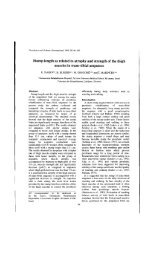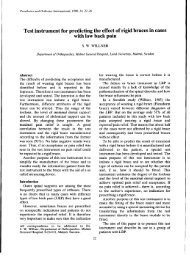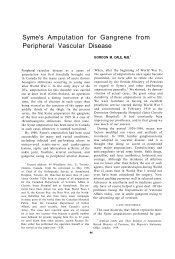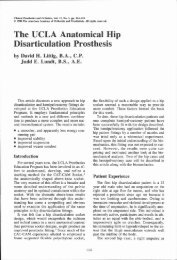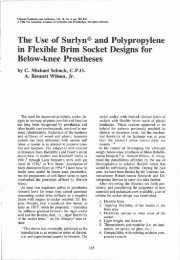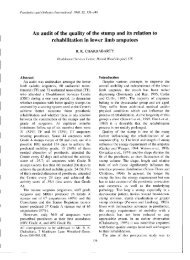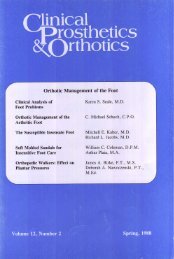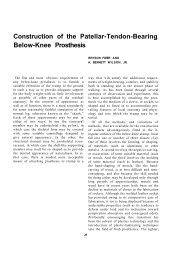The Biomechanics of Control in Upper-Extremity Prostheses
The Biomechanics of Control in Upper-Extremity Prostheses
The Biomechanics of Control in Upper-Extremity Prostheses
Create successful ePaper yourself
Turn your PDF publications into a flip-book with our unique Google optimized e-Paper software.
BIOMECHANICS OF CONTROL 23<br />
on relative motion between shoulders and<br />
pelvis; the nudge control, requir<strong>in</strong>g either<br />
manual or ch<strong>in</strong> operation; extreme shoulder<br />
flexion on the sound side; and extension <strong>of</strong> the<br />
shoulder on the amputated side complete the<br />
array <strong>of</strong> known feasible possibilities. It is<br />
evident that with this class <strong>of</strong> amputees control<br />
motions will be slower and deliberately<br />
sequential. <strong>The</strong>y are therefore necessarily<br />
more noticeable and awkward.<br />
Fig. 21. Coord<strong>in</strong>ated control motions for elbow<br />
lock. Simultaneously the humerus is both extended<br />
(a) and abducted (b) while the shoulder is depressed<br />
(c) and the trapezius is bulged (d) by downward rotation<br />
<strong>of</strong> the scapula.<br />
<strong>The</strong> Shoulder Dual-<strong>Control</strong> System<br />
In the absence <strong>of</strong> the humeral lever, the<br />
shoulder becomes the major power source,<br />
biscapular abduction controll<strong>in</strong>g both forearm<br />
and term<strong>in</strong>al device <strong>in</strong> the dual-control<br />
system. <strong>The</strong> control path courses horizontally<br />
across the scapulae, and either opposite-axilla<br />
loop or basic chest-strap harness<br />
(page 46) captures the action satisfactorily.<br />
<strong>The</strong> comb<strong>in</strong>ation afforded by the dual pr<strong>in</strong>ciple<br />
also is illustrated <strong>in</strong> Figure 20.<br />
<strong>The</strong> shoulder amputee has a special difficulty<br />
<strong>in</strong> obta<strong>in</strong><strong>in</strong>g the comb<strong>in</strong>ation <strong>of</strong> full<br />
forearm flexion and term<strong>in</strong>al-device operation<br />
because, unlike the above-elbow amputee, who<br />
can add the excursions <strong>of</strong> humeral flexion and<br />
scapular abduction, he must obta<strong>in</strong> all movement<br />
from biscapular abduction. Shoulder<br />
amputees with broad shoulders and wide<br />
chests usually achieve this action satisfactorily;<br />
others must accept the limitation <strong>of</strong><br />
partial term<strong>in</strong>al-device operation at full<br />
forearm flexion. Partial-shoulder and forequarter<br />
amputees must depend upon the<br />
sound shoulder entirely, and <strong>in</strong> this case<br />
the action range <strong>of</strong> the term<strong>in</strong>al device<br />
typically is limited to not more than 90 deg.<br />
<strong>of</strong> forearm flexion.<br />
In shoulder amputees, operation <strong>of</strong> the<br />
elbow lock must be managed by various special<br />
arrangements. <strong>The</strong> waist control, utiliz<strong>in</strong>g<br />
shoulder elevation; the per<strong>in</strong>eal strap, based<br />
<strong>The</strong> Shoulder Triple-<strong>Control</strong> System<br />
<strong>The</strong> harness required for the triple-control<br />
shoulder-disarticulation system consists <strong>of</strong> a<br />
chest strap for forearm flexion, a waist strap to<br />
operate the elbow lock, and an oppositeshoulder<br />
loop for prehension. <strong>The</strong> amputee<br />
must have excellent scapular abduction and<br />
must be able to separate it from extreme<br />
opposite-shoulder shrug, and he must have<br />
available good shoulder elevation on the<br />
amputated side. <strong>The</strong> chief advantage <strong>of</strong> the<br />
triple control <strong>in</strong> the shoulder-disarticulation<br />
case is identical to that <strong>of</strong> the triple control <strong>in</strong><br />
the above-elbow case, namely, that the term<strong>in</strong>al<br />
device may be operated fully <strong>in</strong> the<br />
vic<strong>in</strong>ity <strong>of</strong> the mouth. To operate the prosthesis<br />
from an extended position, the amputee<br />
first produces biscapular abduction, thus<br />
rais<strong>in</strong>g the forearm. <strong>The</strong>n, with the forearm<br />
held <strong>in</strong> place, he elevates the shoulder on the<br />
amputated side to lock the elbow. To operate<br />
the term<strong>in</strong>al device, he then flexes the sound<br />
shoulder. Excursion for term<strong>in</strong>al-device operation<br />
is thus unaffected by forearm flexion.<br />
Unfortunately this system must be restricted<br />
to humeral-neck and shoulder-disarticulation<br />
cases. For lack <strong>of</strong> sufficient excursion<br />
on the amputated side, it is unlikely that a<br />
forequarter amputee would be able to use<br />
triple control.<br />
MECHANICAL APPLICATION OF THE MAJOR<br />
CONTROLS<br />
To elucidate practical amputee biomechanics,<br />
it is necessary to refer to several<br />
aspects <strong>of</strong> the connect<strong>in</strong>g mechanism between<br />
amputee and prosthesis <strong>in</strong> the power-transmission<br />
system. Of first importance are the<br />
proximal reta<strong>in</strong>ers, which are located at the



